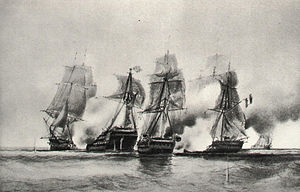
The Minerva-class sailing frigates were a series of four ships built to a 1778 design by Sir Edward Hunt, which served in the Royal Navy during the latter decades of the eighteenth century.

The Coventry-class frigates were 28-gun sixth rate frigates of the Royal Navy, principally in service during the Seven Years' War and the American Revolutionary War. They were designed in 1756 by Britain's Surveyor of the Navy, Sir Thomas Slade, and were largely modeled on HMS Tartar, which was regarded as an exemplar among small frigates due to its speed and maneuverability. The 1750s were a period of considerable experimentation in ship design, and Slade authorized individual builders to make "such alterations withinboard as may be judged necessary" in final construction.
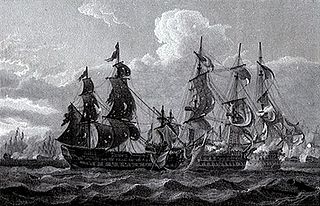
The Canada-class ships of the line were a series of four 74-gun third rates designed for the Royal Navy by William Bateley. The name ship of the class was launched in 1765.

The Ramillies-class ships of the line were a class of nine 74-gun third rates, designed for the Royal Navy by Sir Thomas Slade.
The Albion-class ships of the line were a class of five 74-gun third rates, designed for the Royal Navy by Sir Thomas Slade.
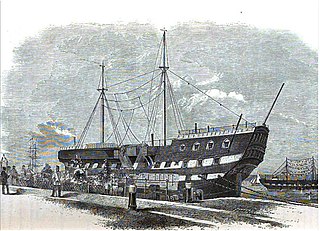
The Alfred-class ships of the line were a class of four 74-gun third rates for the Royal Navy by Sir John Williams. They were an enlarged version of the Royal Oak class.

The Intrepid-class ships of the line were a class of fifteen 64-gun third rates, designed for the Royal Navy by Sir John Williams. His design, approved on 18 December 1765, was slightly smaller than Sir Thomas Slade's contemporary Worcester-class design of the same year, against which it was evaluated competitively. Following the prototype, four more ships were ordered in 1767–69, and a further ten between 1771 and 1779.

The Inflexible-class ships of the line were a class of four 64-gun third rates, designed for the Royal Navy by Sir Thomas Slade. The lines of this class were based heavily on Slade's earlier 74-gun Albion-class.
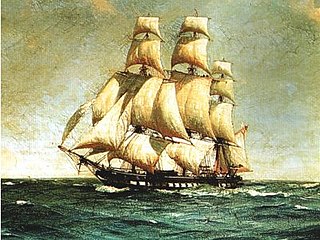
The Magicienne class was a class of twelve fifth rate 32-gun frigates of the French Navy, each with a main battery of 26 x 12-pounder long guns, and with 6 x 6-pounder guns on the quarterdeck and forecastle. They were designed by Joseph-Marie-Blaise Coulomb.
The Mermaid-class frigates were a group of six 28-gun sailing frigates of the sixth rate designed in 1760 by Sir Thomas Slade, based on the scaled-down lines of HMS Aurora.

The Enterprise-class frigates were the final class of 28-gun sailing frigates of the sixth-rate to be produced for the Royal Navy. These twenty-seven vessels were designed in 1770 by John Williams. A first batch of five ships were ordered as part of the programme sparked by the Falklands Islands emergency. Two ships were built by contract in private shipyards, while three others were constructed in the Royal Dockyards using foreign oak.
The Southampton-class frigates were 32-gun sailing frigates of the fifth rate produced for the Royal Navy. They were designed in 1756 by Sir Thomas Slade, and were the first 'true' fifth-rate frigates produced to the new single-deck concept. They were, however, designed with sweep ports along the lower deck.

The Niger-class frigates were 32-gun sailing frigates of the fifth rate produced for the Royal Navy. They were designed in 1757 by Sir Thomas Slade, and were an improvement on his 1756 design for the 32-gun Southampton-class frigates.
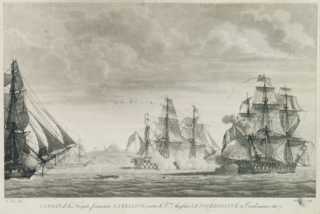
The Iphigénie class was a group of nine 32-gun/12-pounder frigates of the French Navy, built during the late 1770s at Lorient and Saint Malo. They were designed by Léon Guignace. The seven built at Saint Malo were initially numbered Nos. 1 – 7 respectively, and not given names until October 1777 and the start of 1778 ; all seven were captured by the British Navy between 1779 and the end of 1800. Of the two built at Lorient, the Spanish captured one, and a storm wrecked the other.
The Adventure-class ship was a class of eight 44-gun sailing two-decker warships of the Royal Navy, classed as a fifth rate like a frigate, but carrying two complete decks of guns, a lower battery of 18-pounders and an upper battery of 12-pounders. This enabled the vessel to deliver a broadside of 318 pounds.

The Nymphe class was a class of four 34/44-gun frigates of the French Navy, designed in 1781 by Pierre-Augustin Lamothe. The prototype (Nymphe) was one of the earliest of the frigates to be armed with 18-pounder long guns. The first two - Nymphe and Thétis - carried 34 guns comprising twenty-six 18-pounders on the upper deck and eight 8-pounders on the quarterdeck and forecastle. The latter two - Cybèle and Concorde - carried an increased armament of 44 guns comprising twenty-eight 18-pounders on the upper deck and twelve 8-pounders plus four 36-pounder obuses on the quarterdeck and forecastle. Thétis was retro-fitted by 1794 to carry the same increased armament as the last two; she was rebuilt at Rochefort from October 1802 to September 1803.

The Flora-class frigates were 36-gun sailing frigates of the fifth rate produced for the Royal Navy. They were designed in 1778 by Sir John Williams in response to an Admiralty decision to discontinue 32-gun, 12-pounder (5.4 kg), vessels. Williams proposed a frigate with a main battery of twenty-six 18-pound (8.2 kg) guns and a secondary armament of ten 6 pounders (2.7 kg). Four 18-pounder carronades and 12 swivel guns were added to the upperworks in September 1799 and the 6-pound long guns were upgraded to 9-pounders in April 1780, before any of the ships were completed.
John Barnard (1705–1784) was an 18th century English shipbuilder serving the Royal Navy.
Sir Edward Hunt (c.1730–1787) was a British shipbuilder and designer who rose to be Surveyor of the Navy.


